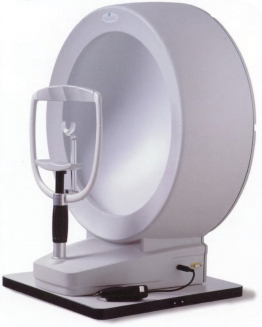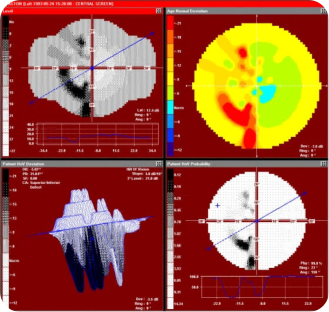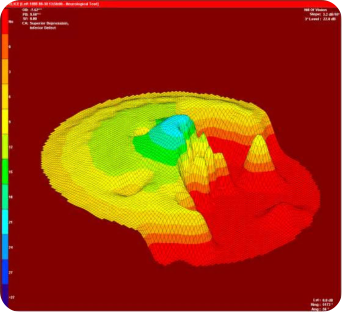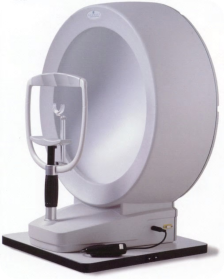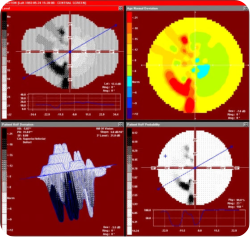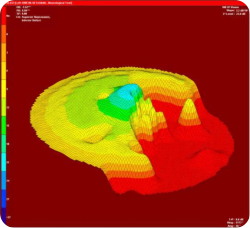As a patient of ours you are already aware of the importance of eye examinations. Apart from sight correction, regular examinations allow our optometrists to
inspect your eyes for numerous conditions that affect general health as well as those that can affect your vision. A basic assessment of your visual fields is
often carried out during a standard eye test. If there is a history of glaucoma then it will always be undertaken. It provides the optometrist with an indication of
the sensitivity of your vision over a 30° field of view.
What is the new method of assessment?
The instrument that is used during a standard assessment of your visual field is designed to detect areas of your vision
that have reduced vision for whatever reason. Our new Analyser (called an Automated Perimeter) allows the
optometrist to run many different types of test. It can analyse your visual field over a much larger area and in much
more detail. It is designed to be much more sensitive to small variations in perception and can explore any problem
areas with much greater precision. It can also test binocular vision with a field of view up to 160° making it a very
flexible diagnostic tool. It incorporates various testing methods aimed at testing for types of glaucoma, neurological
conditions, macular sensitivity, peripheral sensitivity and other specialist testing.
Why is it recommended?
There are a number of good reasons for a full investigation of the visual fields but the single most important reason
(and the reason we carry out a basic screening as part of many normal eye tests) is in the detection of glaucoma.
Glaucoma is the leading cause of preventative blindness in the United Kingdom and is found to some extent in 1 in 50 people over the age of 40. It can affect
children and younger adults, though this is less common. It is due to a build-up of fluid within the eye leading to pressure on the optic nerve. The symptoms
are not obvious to the individual until the disease is well established. Vision that is lost to glaucoma can never be recovered, though early detection and
treatment can prevent future damage. Because of the hereditary links, those who have glaucoma, or have
close relatives with the condition, are encouraged to have regular eye tests incorporating basic screening
annually, and to undergo this more detailed assessment at least every couple of years, or as recommended by
your optometrist. Apart from glaucoma, there are other conditions that can be diagnosed; diseases of the
macula (central area of vision) and other neurological conditions can also be assessed using this new
perimeter. Since our new equipment will plot and store detailed information about your own eyes, we are
able to detect any variations much sooner. As with many medical conditions, it is the comparison of results
taken over a period of time that allows detection of problems at an earlier stage.
What is involved?
Since the equipment is capable of assessing or testing for various conditions, and because the test will
automatically adapt to your own needs, the length of time taken for this procedure can vary greatly. An in-
depth glaucoma assessment, or neurological analysis may take 15 minutes or more. In most cases the advanced analysis would have been advised because the
basic screening showed an area that needed further investigation. This may only take 8 minutes or so depending on the outcome of the test. Whichever test
routine is being undertaken, the process is similar and involves looking into a bowl-shaped disc. Small lights of varying intensity and position are briefly
illuminated and you will need to respond by pressing a button. You will be shown how to respond before
the test starts, and unlike older equipment there is no ‘closed-in’ feeling that some people find
claustrophobic.
How much does it cost, and how often should it be carried out?
Unfortunately these types of in-depth field analysis goes well beyond the basic requirements and is not
funded by the National Health Service (unless the hospital has specifically arranged for us to carry out
analysis on their behalf). There are different charges for different types of tests - please contact us for
advise or ask your optometrist what they recommend. Your optometrist is the best judge of how often this
should be carried out but as a guideline those over 35 should consider an initial assessment, if only to check
for glaucoma, followed perhaps every few years. You would probably be advised to increase the frequency
where glaucoma is present, or whenever the basic screening during an eye test presents any symptoms.
As a patient of ours you are already aware of the importance of eye
examinations. Apart from sight correction, regular examinations
allow our optometrists to inspect your eyes for numerous
conditions that affect general health as well as those that can affect
your vision. A basic assessment of your visual fields is often carried
out during a standard eye test. If there is a history of glaucoma
then it will always be undertaken. It provides the optometrist with
an indication of the sensitivity of your vision over a 30° field of view.
What is the new method of
assessment?
The instrument that is used
during a standard assessment
of your visual field is designed
to detect areas of your vision
that have reduced vision for
whatever reason. Our new
Analyser (called an Automated
Perimeter) allows the
optometrist to run many
different types of test. It can
analyse your visual field over a much larger area and in much more
detail. It is designed to be much more sensitive to small variations
in perception and can explore any problem areas with much
greater precision. It can also test binocular vision with a field of
view up to 160° making it a very flexible diagnostic tool. It
incorporates various testing methods aimed at testing for types of
glaucoma, neurological conditions, macular sensitivity, peripheral
sensitivity and other specialist testing.
Why is it recommended?
There are a number of good reasons for a full investigation of the
visual fields but the single most important reason (and the reason
we carry out a basic screening as part of many normal eye tests) is
in the detection of glaucoma. Glaucoma is the leading cause of
preventative blindness in the United Kingdom and is found to some
extent in 1 in 50 people over the age of 40. It can affect children
and younger adults, though
this is less common. It is
due to a build-up of fluid
within the eye leading to
pressure on the optic nerve.
The symptoms are not
obvious to the individual
until the disease is well
established. Vision that is
lost to glaucoma can never
be recovered, though early
detection and treatment can prevent future damage. Because of
the hereditary links, those who have glaucoma, or have close
relatives with the condition, are encouraged to have regular eye
tests incorporating basic screening annually, and to undergo this
more detailed assessment at least every couple of years, or as
recommended by your optometrist. Apart from glaucoma, there
are other conditions that can be diagnosed; diseases of the macula
(central area of vision) and other neurological conditions can also
be assessed using this new perimeter. Since our new equipment
will plot and store detailed information about your own eyes, we
are able to detect any variations much sooner. As with many
medical conditions, it is the comparison of results taken over a
period of time that allows detection of problems at an earlier stage.
What is involved?
Since the equipment is capable of assessing or testing for various
conditions, and because the test will automatically adapt to your
own needs, the length of time taken for this procedure can vary
greatly. An in-depth glaucoma assessment, or neurological analysis
may take 15 minutes or more. In most cases the advanced analysis
would have been advised because the basic screening showed an
area that needed further investigation. This may only take 8
minutes or so depending on the outcome of the test. Whichever
test routine is being undertaken, the process is similar and involves
looking into a bowl-shaped disc. Small lights of varying intensity
and position are briefly
illuminated and you will
need to respond by
pressing a button. You will
be shown how to respond
before the test starts, and
unlike older equipment
there is no ‘closed-in’ feeling
that some people find
claustrophobic.
How much does it cost, and how often should it be carried out?
Unfortunately these types of in-depth field analysis goes well
beyond the basic requirements and is not funded by the National
Health Service (unless the hospital has specifically arranged for us
to carry out analysis on their behalf). There are different charges
for different types of tests - please contact us for advise or ask your
optometrist what they recommend. Your optometrist is the best
judge of how often this should be carried out but as a guideline
those over 35 should consider an initial assessment, if only to
check for glaucoma, followed perhaps every few years. You would
probably be advised to increase the frequency where glaucoma is
present, or whenever the basic screening during an eye test
presents any symptoms.
